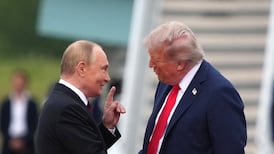Shinzo Abe, who was assassinated on Friday, was Japan’s longest serving prime minister.
He had two terms in the job, from 2006 to 2007 and again from 2012 to 2020. In his second spell in office, he staked out a conservative position that won him popularity with nationalists but made him a controversial figure, particularly on the left.
Typical of his forthright approach was his early political embrace of Donald Trump. While the rest of the world dithered about how to deal with America’s unpredictable new president-elect, Abe went to meet him, carrying a gold-plated golf driver as a gift. Some noted that Abe had a better rapport with strongmen such as Trump than his more liberal predecessor Barack Obama.
Abe fought for a more muscular military role as America’s ally in Asia, pushing through a controversial reinterpretation of Japan’s war-renouncing constitution. Even after leaving office complaining of ill-health, he continued to be a force in conservative politics, leading the biggest faction in the ruling Liberal Democratic Party and advocating increased military spending.
RM Block
In February, he floated the idea of a Nato-style arrangement with America to “share” nuclear weapons in Japan, as a hedge against aggression by nuclear-armed China, a proposal that infuriated many in the only country in the world to have suffered a nuclear attack.
Abe tried to revive Japan’s flagging economy and became an ambassador for global free trade, forcing through several key agreements, including the Japan-EU free trade deal. His energy and drive marked him out after a string of mostly anonymous, short-lived leaders.
[ Former Japanese prime minister Shinzo Abe shot deadOpens in new window ]
His economic policies — deficit spending and monetary tinkering to end years of deflation — fuelled corporate profits and the stock market, and weakened the yen, helping to fuel a tourism boom. But by the time he quit, many of these gains had been reversed.
His detractors say he failed to change the status quo or reverse Japan’s economic decline, and worsened foreign relations, particularly with South Korea, by disputing the history of Japan’s misdeeds during the second World War.
Nevertheless, he overcame multiple scandals to become the longest serving leader in Japan’s history, overtaking his uncle, Eisaku Sato. His sheer resilience marks him as one of the country’s most notable leaders.
His inability, however, to rewrite the postwar constitution, written while Japan was under occupation by its former enemies, dogs his political legacy among his conservative supporters.
All this makes his murder more puzzling. Naturally at home on the political right, his enemies were considered to be on the left. Initial reports suggest his attacker was a former member of the Self-Defence Forces, not of Japan’s mostly moribund radical left who might ordinarily have been suspected.
Political violence is rare in Japan, though it was not always so. Until recently, leftwing revolutionaries launched erratic mortar attacks on establishment targets such as the Kyoto Imperial Palace and visiting American presidents (they once dispatched five home-made rockets at the state guest house where Ronald Reagan and other world leaders were gathered).
Abe’s grandfather Nobusuke Kishi, who was also prime minister, from 1957 to 1960, himself survived an assassination attempt in his home.
Much of Japan’s postwar political violence came from the right. Inejiro Asanuma, then leader of the Japan Socialist Party was fatally stabbed with a sword by a teenage ultranationalist in 1960 during a televised debate. Several other politicians have been attacked over the years since.
Hitoshi Motoshima, then mayor of Nagasaki, barely survived an assassination attempt by ultra-rightists in 1990 after he suggested Emperor Hirohito bore responsibility for the second World War.
Yet, such violence has declined and contemporary politicians are often lightly guarded. Abe could be seen walking around his home in Shibuya, near the centre of Tokyo, with a single security official. He appeared to be just a few feet away from the public when he was shot on Friday.
Because guns are strictly regulated and hard to come by in Japan, some have speculated that the weapon used to kill Abe was home-made. That suggests military training and is another reason why all eyes will now fall on the background of Abe’s alleged killer in the coming days.


















